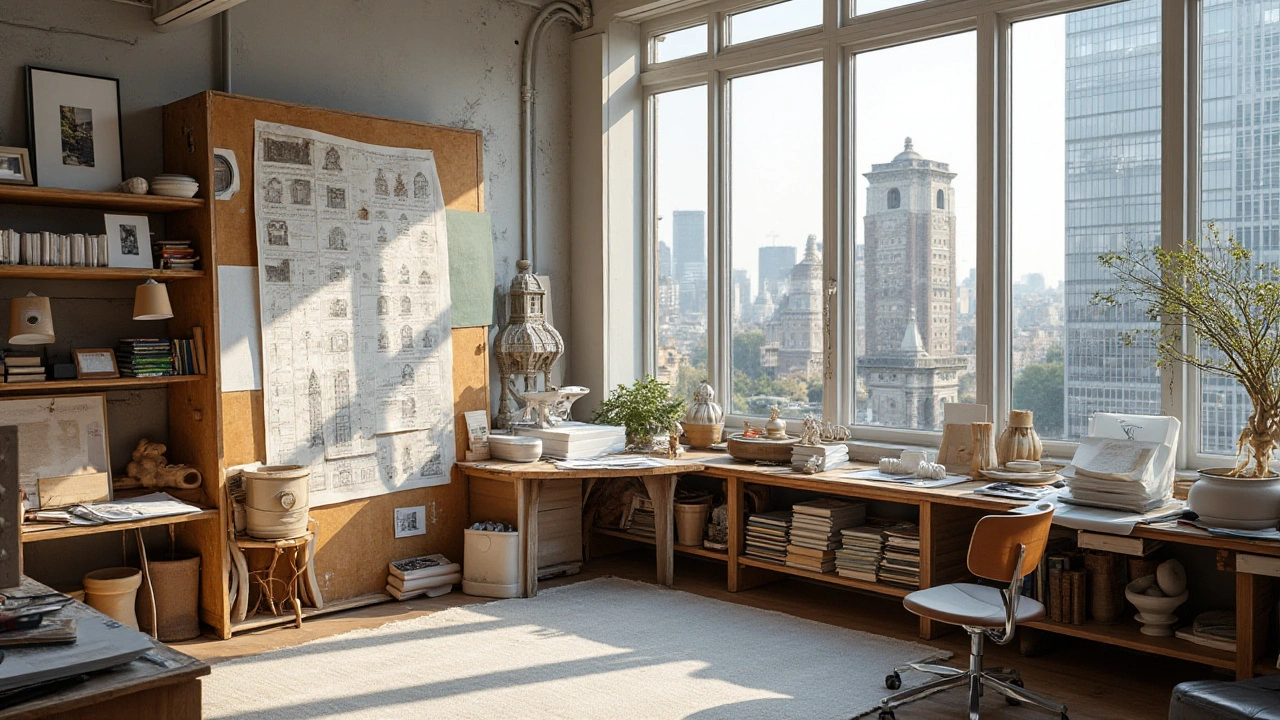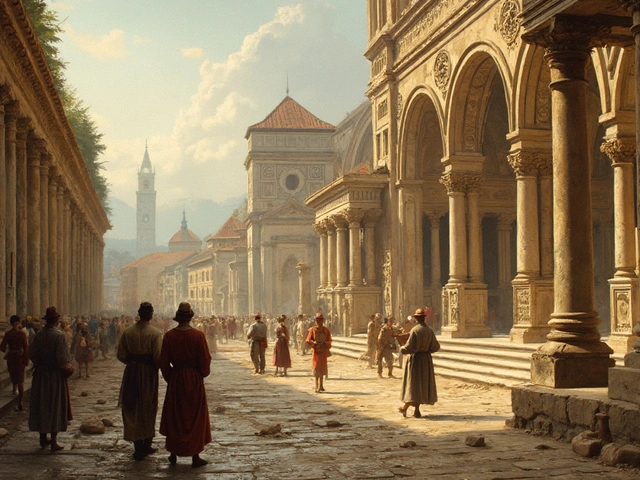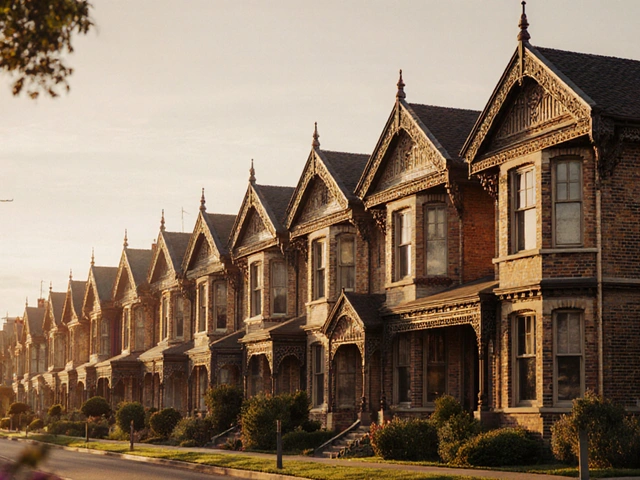Italianate architecture, a style that first made its mark in the mid-19th century, is witnessing a compelling resurgence in modern design landscapes. Originally inspired by the romanticism of 16th-century Italian Renaissance villas, this architectural form stands out with its distinctive use of brackets, cornices, and tall, narrow windows adorned with arches. Its appeal lies not only in its aesthetic beauty but also in the way it evokes a sense of history and elegance.
Today, as homeowners and designers seek to combine classical elements with the needs of contemporary living, Italianate architecture offers a perfect blend of the old and the new. The style's ability to seamlessly integrate with modern materials and technology makes it both a charming and practical choice for new constructions and renovations. As we explore this fascinating renaissance, we delve into the style's origins, key features, and how it can be adeptly woven into the fabric of today's architectural projects.
- Origins and Development of Italianate Architecture
- Key Features and Characteristics
- Modern Interpretations and Adaptations
- Notable Examples Worldwide
- Incorporating Italianate Design in Contemporary Spaces
Origins and Development of Italianate Architecture
The genesis of Italianate architecture traces back to the picturesque movement of the late 18th and early 19th centuries, a period characterized by a yearning for the romantic allure of Italy's rural and classical landscapes. It gained momentum in Britain, where architects sought to move away from the rigid formality of Georgian styles. This architectural style was inspired by the informal and rustic villas of the Italian countryside, which appealed to English tastes seeking variety and picturesqueness in architectural design. Moving into the Regency period, designers started to incorporate Italianate elements into their works, emphasizing asymmetry and adopting features such as low-pitched roofs and wide eaves supported by decorative brackets.
Italianate style quickly crossed the Atlantic, becoming a dominant architectural language in the United States during the 1840s through the 1880s. It reached the height of its popularity during the antebellum period and became a staple for public buildings, grand homes, and even smaller domestic architecture. One of the key propagators of this style was the influential architect Andrew Jackson Downing, who, through his pattern books, popularized Italianate designs as symbols of cultured and refined living. In his seminal work, Downing proclaimed that the style represented an "idyllic architecture," reflecting the character of those who occupied such dwellings.
The typical characteristics of Italianate architecture—such as the use of cupolas, towers, and decorative cast iron—were not simply aesthetic choices but also practical solutions that accommodated climatic conditions and the technological advancements of the industrial age. Builders favored Italianate designs because they were adaptable to a variety of building sizes and shapes, making them ideal for urban as well as rural settings. Moreover, as cities expanded during the Industrial Revolution, the style's versatility allowed it to cater to commercial and residential needs alike, contributing to its widespread adoption.
An often-cited example of this architectural influence in the United States is the iconic Leland Stanford Mansion in Sacramento, California. This beautiful Italianate structure entwines history and artistry, showcasing the defining features of tall windows, ornate cornices, and a commanding central tower. The style’s timeless elegance and adaptability continue to captivate modern architects and homeowners, ensuring its place in contemporary design. Architectural historian John Harris noted, "The Italianate style was a direct expression of the quest for harmonious beauty and the humanistic spirit of the era," a sentiment that underpins much of its appeal today.
Key Features and Characteristics
The lush elegance of Italianate architecture lies in its ability to transport our imagination to the sun-drenched realms of Italy without leaving modern boundaries. This architectural style, prominent during the 19th century, is characterized by its penchant for ornamentation and intricate detailing. One of the defining features of the Italianate style is the low-pitched or flat roof, often crafted with a unique cupola or tower that punctuates the skyline, adding visual interest and height to these buildings. These roofs typically project outwards, lined with decorative brackets—a hallmark of the style—which embellish the eaves with striking repetition.
The windows in Italianate buildings are typically elongated and often rounded or segmented at the top, drawing from classical Roman designs. Their tall, narrow shape is reminiscent of the villas that line the Italian countryside. In many cases, windows are crowned with arches or hood moldings that add another layer of depth and detail. These elements are not just for show; they elevate the facade's texture and help articulate the layered beauty of the style. Italianate homes also frequently showcase bay windows that add breadth to rooms, creating spaces filled with light and viewing angles of the outside world.
Another key aspect is the use of quoins, which are the cornerstones of the building. These can be seen in the masonry work that often uses contrasting colors or stones to accentuate the building's edges. Decorative elements do not stop there; doorways often feature heavy drapery-style moldings that make grand entries all the more majestic.
"The Italianate style's blend of elegance and charm continues to be revered, offering architects a palette for creativity that balances historical allure with modern sensibility," said architectural historian Sarah Powers in a 2023 interview.Such features set the Italianate style apart from its contemporaries, imbibing a sense of opulence that is both inviting and awe-inspiring. The intentional play with symmetry, seen in the layout and the distribution of windows and doors, suggests harmony and balance that is deeply rooted in Renaissance traditions.
Many modern adaptations also take advantage of these traditional characteristics while incorporating new materials. For instance, builders today might employ eco-friendly substitutes like bamboo for the ornate brackets or recycled glass for window facades. A glance through any city's more venerable districts will reveal an enduring penchant for this architectural form, its features as relevant today as they were in yesteryear. Contemporary projects tend to respect the original aesthetic while enhancing it with technological conveniences—something Italianate's original architects could only imagine. This melding of the past and the present ensures Italianate architecture not only retains its allure but actively enhances modern cityscapes around the world.

Modern Interpretations and Adaptations
In recent years, the architectural world has seen a fascinating movement where the classical elegance of Italianate architecture is being reimagined to cater to contemporary needs and tastes. This revival isn't merely about replicating the old but instead focuses on blending historical aesthetics with modern functionality. One of the most exciting aspects of this trend is the use of sustainable materials that echo the past's grandeur while meeting today's environmental standards. Modern architects often choose to incorporate eco-friendly elements without sacrificing the characteristic charm of the Italianate style. This results in structures that not only look beautiful but also reduce their carbon footprint.
With urbanization on the rise, space constraints have pushed designers to creatively adapt Italianate features in smaller and more efficient layouts. Today's architects create these adaptations by experimenting with vertical lines and narrow profiles that are reminiscent of traditional Italianate narrow windows but are redefined for modern high-rise structures. Glass facades with arched window designs can imbue a modern building with the timeless allure of the Italianate, all while allowing natural light to flood the interiors. This clever blend ensures that even the most modern of constructions can maintain an air of classic sophistication.
A significant aspect of reviving Italianate architecture in today’s world is technology integration. Smart home devices and energy-efficient systems are seamlessly incorporated into these beautifully styled buildings. It is not uncommon now to see a building that, from the outside, looks like it belongs in a 19th-century painting, yet inside houses the latest in modern conveniences. This marriage of old and new is increasingly appealing to homeowners who seek the character of historical designs alongside the practicalities of modern living.
There are several notable examples of this harmonious blend, particularly in the renovations of heritage homes where regulations demand preservation of the original facade. Architects often face the challenge of enhancing these homes' interiors while respecting their historical significance. They achieve this by using open plan designs that contrast with the ornately decorated exteriors, leading to a captivating juxtaposition of styles. Such methods have allowed for the preservation of many culturally significant buildings, breathing new life into them while retaining their rich history.
According to leading architect Maria Rizzo, "The key to successfully blending the modern revival of historic styles like Italianate into contemporary life is respect for the past. It's about creating dialogue between eras through design."
The appeal of Italianate architecture's resurgence is not limited to traditional homes alone. This style has found its way into commercial properties, where its graceful lines and ornamentation offer a refreshing divergence from the often stark and minimalist contemporary commercial architectures. The decorative brackets and cornices that typify Italianate structures provide a striking yet approachable facade for businesses eager to stand out and attract a clientele that appreciates artistry and historical beauty.
Notable Examples Worldwide
Italianate architecture has an enchanting legacy that echoes across continents, and its majestic form can be seen in a variety of locales that celebrate its grandeur. One of the quintessential examples is the Ware's Folly in Augusta, Georgia. Built in 1818, this structure is renowned for its notable brickwork and elegant arched windows, making it a classic representation of the Italianate style in America. Visitors are often drawn to its beautifully ornate facade, which stands as a testament to the craftsmanship of the era. A keen observer will notice the extensive use of brackets under wide verandas, a hallmark of the Italianate design.
Heading across the Atlantic, in the heart of London, the Reform Club stands proudly on Pall Mall. This iconic building, constructed in the 1830s, showcases the elegance of Italianate elements through its refined portico and richly detailed stonework. The club has played host to many influential figures and has been immortalized in literature. Its timeless appeal captures the balance of opulence and restraint that defines the style, with interiors that reflect the grandeur of historic Italian villas.
In Australia, the State Library of Victoria in Melbourne stands as a striking example. Finished in 1856, it embodies Italianate grandeur with its towering columns and spacious galleries. The library invites visitors to explore its vast collection while surrounded by the beauty of Italianate architecture, harmoniously blending space and function. The building's ability to merge these attributes has turned it into a cultural landmark that continues to inspire Australian architects today.
A significant dimension of Italianate diffusion is seen in South Africa with the Unisa Sunnyside Campus in Pretoria. Although adapted to suit a unique climate and landscape, its architectural footprint retains key elements of the style, visible in its symmetrical design and stylized window frames. Throughout its halls, the marriage of solidity and elegance speaks to the enduring nature of Italianate principles.
"Architecture should speak of its time and place, but yearn for timelessness," famously noted Frank Gehry, reflecting a sentiment that aptly describes the Italianate style’s enduring allure.
Remarkably, the revival of the Italianate model also permeates parts of Asia, with Singapore's Empress Place Building illustrating this. Originally erected in 1865 as government offices, this building now functions as a museum. It highlights Italianate architecture's affinity with civic and cultural hubs, employing classical motifs such as pilasters and expansive porticos that facilitate airflow—a clever adaptation specific to tropical climates.
These examples underscore the rich tapestry of Italianate architecture across the globe. The style's fluid adaptability and intrinsic beauty have allowed it to flourish in a myriad of environments, constantly inviting new generations to explore its possibilities. As architects and designers continue to draw inspiration from these storied structures, the enduring legacy of Italianate architecture remains not only a tribute to historical craftsmanship but also a lens for visionary innovations.

Incorporating Italianate Design in Contemporary Spaces
In the shifting sands of modern architecture, integrating the classic allure of Italianate architecture offers a gateway to blend the old with the new seamlessly. This architectural style, with its roots deeply planted in the grandeur of the Italian Renaissance, finds itself reimagined in today's homes and public spaces. To incorporate it effectively, designers often focus on balancing the ornate elegance of traditional elements with the streamlined look of contemporary design. Key features like corbels and cornices, which once adorned the facades of grand estates, can now be skillfully used in interiors to add depth and dimension. For instance, adding arched windows or tall door frames can bring a touch of sophistication and historical charm to living spaces, capturing that quintessential Italianate feel.
One of the most significant aspects of integrating Italianate style today lies in its adaptability to modern materials and technology. Glass and steel, for instance, offer new interpretations of the characteristic tall, narrow windows, allowing natural light to flood contemporary interiors without losing the style's signature look. In kitchens and bathrooms, designers are playing with textures and materials to echo the ornate roots of Italianate design. Bracketed eaves can be simulated with modern, lightweight materials that support eco-friendly designs, thus bringing sustainable practices into a space that speaks to both past and present.
“The marriage of traditional styles with modern technology presents an opportunity to achieve timeless beauty,” says renowned architect Maria Leonardi. “It’s about understanding the soul of the design while meeting the needs of today.”
For those looking to bring Italianate flair into contemporary living spaces, it’s crucial to focus on details. Intricate doorways and expansive verandas reminiscent of Italian villas are becoming popular in suburban homes. This can include creating outdoor spaces with columned porches that invite the essence of Mediterranean lifestyle into a modern context. A well-planned landscape that complements architectural elements can further enhance this style, using native plants to mirror the lush, yet tamed feeling of a traditional Italian garden.
Practical Tips for Modern Adaptations
When adapting Italianate architecture into modern spaces, consider the use of color and texture as vital tools. The palette traditionally associated with Italianate architecture – muted earth tones, ochres, and terra cottas – can be modernized with subtler tones and bolder accents to match contemporary interiors. Attention to these nuanced color schemes will resonate with the historical underpinnings while offering a refreshed perspective suitable for today’s tastes. Additionally, incorporating textured finishes like stucco or engineered wood facades can mimic historical craftsmanship in a contemporary setting.
| Element | Traditional | Modern Adaptation |
|---|---|---|
| Cornices | Wood or stone detailing | Metal or composite materials |
| Windows | Arched, wooden frames | Steel or aluminum frames with energy-efficient glass |
| Columns | Masonry | Engineered materials for sustainability |
The versatility of Italianate style offers a unique opportunity to create spaces that are not only beautiful but also functional and forward-thinking. As contemporary designers continue to explore this rich architectural language, Italianate design will no doubt leave its imprint on the landscape of modern architecture, blending the romance of history with the possibilities of tomorrow.





